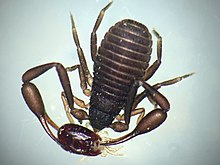en
names in breadcrumbs


Pseudoscorpions are a group of generally small arachnids (adults typically 0.5 to 5 mm long) that are not often encountered by most people. For those alert to tiny creatures, however, the most frequently encountered species is probably the House Pseudoscorpion (Chelifer cancroides). This species has a cosmopolitan distribution and often occurs in human dwellings or other buildings.
House Pseudoscorpions are 3 to 4 mm in length and have a rich mahogany color. The four pairs of legs increase sequentially in length from the 1st to the 4th pair. There is a single eye on each side of the cephalothorax (head plus thorax) and a 12-segmented abdomen (although only ten segments are easily visible). Excluding appendages, the body resembles a teardrop. The pedipalps, located in front of the first pair of legs, are more than twice as long as the legs. When extended, crab-like, they measure 7 to 9 mm across.
Mature male House Pseudoscorpions establish a mating territory 1 to 2 cm in size. They rub their ventral (lower) surface on the center of this territory, possibly depositing pheromones. When a female enters this area, the male begins a mating dance by rapidly vibrating his body and displaying his pedipalps. He deposits a spermatophore (a sperm packet) on the substrate, moves backwards over it, and guides the female on top of it. The entire mating process takes from 10 minutes to 1 hour.
The female produces 20 to 40 eggs which she carries beneath her abdomen. After the young House Pseudoscorpions (which resemble miniature adults) emerge, they stay with the female for several days, sometimes riding on her back. The entire brood then disperses. This entire process, from egg deposition to brood dispersal, can take 3 weeks.
The young House Pseudoscorpions molt three times before adulthood. The developmental period is temperature-dependent, but ranges from around 10 to 24 months. Adults do not molt and can live for 3 or 4 years.
Pseudoscorpions pose no danger to humans, but they may pose a substantial threat to even tinier arthropods that may be living in their vicinity. Unlike the superficially similar true scorpions, pseudoscorpions lack a stinger in the tail, but instead possess poison glands in the pedipalps with which they imobilize prey (e.g., mites). Once captured, their victims are torn open with the chelicerae and the body fluids are sucked out. Like some other pseudoscorpions, House Pseudoscorpions may disperse by hitching a ride with a larger arthropod (often a flying insect), grabbing onto a host with their pedipalps. House Pseudoscorpions may be found tagging along with house flies.
(Brusca and Brusca 2003; Jacobs 2006)
Chelifer cancroides, the house pseudoscorpion, is a species of pseudoscorpion. It is cosmopolitan, synanthropic and harmless to humans.[1]
There are two subspecies:[2]
Chelifer cancroides measure 2.5–4.5 mm (0.098–0.177 in) in length. The pedipalps are very long,[3] measuring 7–9 mm (0.28–0.35 in) when extended. The body is teardrop-shaped and has a rich mahogany color. The abdomen has 12 segments, only 10 of which are easily visible. The cephalothorax has one pair of eyes.[1]
This species can be distinguished from other Cheliferidae by a number of features. The carapace has large setose tubercles. In males, the carapace and tergites I-VII or I-VIII have distinct lateral keels. The cheliceral hand has 4 setae, lacking seta sbs. The tarsal claws of adults have a lateroventral process, except for those on the first leg pair of adult males. Additionally, the suberminal tarsal setae are denticulate. In males, coxa IV is strongly arcuate, has a large lateral process, and has a coxal sac lacking a differentiated atrium. The male genitalia have rams horn organs and an anteriorly invaginated lateral rod forming a median depression, in which lies a sclerotic rod. The female genitalia have paired spermathecae and paired median cribriform plates.[4]

Chelifer cancroides feeds on small arthropods such as psocids, fruit flies and mites such as Varroa.[5]
Males maintain small mating territories, few centimeters in size. When a female enters the territory, the male initiates a mating dance and eventually deposits a spermatophore, which is then picked up by the females. Fecundity is 20–40 eggs. The development from egg stage into maturity takes 10 to 24 months and involves three molts;[1] molting may involve building a silk nest.[3] They usually live three or four years.[1]
Chelifer cancroides has been observed in North America, Europe, Africa, and Australia.[6]
Chelifer cancroides has been found under bark of trees, in caves, in bird nests and bee nests, and riding on bats, flies and hymenopterans.[7] It also occurs in human structures such as houses, stables, barns, chicken coops and bee hives.[4]
Like some other pseudoscorpions, C. cancroides has venomous pedipalps used for subduing prey. This venom contains various peptides and is toxic to bacteria (e.g. methicillin resistant Staphylococcus aureus), fungi, arthropods (e.g. aphids and Varroa mites) and mammalian cells.[5][8]
Chelifer cancroides, the house pseudoscorpion, is a species of pseudoscorpion. It is cosmopolitan, synanthropic and harmless to humans.